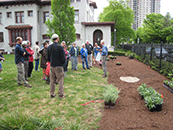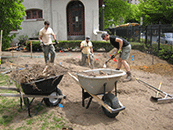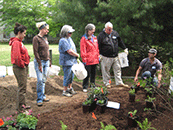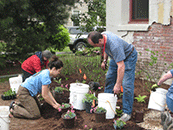Springfield Rain Gardens
Keeping polluted storm flows from entering rivers and streams is central to the Springfield Rain Gardens Project. Led by the Pioneer Valley Planning Commission (PVPC) and the Regenerative Design Group (RDG), this initiative entails building up to 10 rain gardens in the City.
One brand new rain garden facility at the Springfield Museums captures storm flow from 1,770 square feet of roof top. This translates into 33,000 gallons of rainfall taken up by plants and soaked up by soils in a single year. By keeping this rainfall from flowing over local streets, there is less polluted urban flow entering the Connecticut River.
The Springfield Rain Gardens Project also has an important hands-on training component where workshops are helping people learn how to build and maintain such facilities themselves. The construction of the Springfield Museums Garden drew more than 20 people who learned about construction and helped plant a variety of perennials in the rain garden.
Smaller gardens are being constructed or have been constructed at several residential properties and another large garden is planned for the Gardening the Community's new site at Walnut and James Streets. One rain garden at a time can add up and it is hoped that as these types of facilities catch on with homeowners, institutional properties, commercial properties, etc. that they can also make a difference in beautifying the landscape of the city and reducing localized flooding.
Grants for rain garden design and construction are being provided to Springfield property owners by PVPC through a competitive application process. Funding for this work comes from a settlement agreement reached by Clean Water Action, a non-profit citizens’ group. If you are interested in applying, contact Patty Gambarini at pgambarini@pvpc.org or 413-781-6045.
 |
 |
 |
 |

